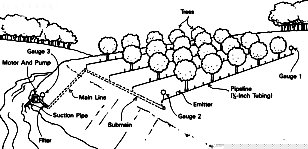
- Home
- Managing An Irrigation System
- Planning System Hardware
- Farm Irrigation Systems & Cost Analysis
- Water Resource Development
- Micro Irrigation Handbook
- Related Links
The Drip Irrigation System
Operational, Energy and Planning Requirements
Larry M. Curtis, Agricultural Engineer-Soil & Water
Ted W Tyson, Agricultural Engineer-Irrigation
Drip irrigation supplies water directly to individual plants rather than wetting the entire soil surface. There is a variety of drip irrigation systems and equipment. The main function of these systems is to move water from the water source to the vicinity of the plant and to slowly apply this water through devices called emitters.
Normally, drip irrigation systems are operated on a daily or every-other-day basis to supply the daily water needs of the crop. Drip irrigation is most often used for fruit tree crops such as peaches, blueberries, grapes, apples, pecans, and citrus. It is also used for vegetable crops such as strawberries and tomatoes.
The energy required of an irrigation system is closely related to the total pressure required in the system. Drip irrigation operates at lower pressure than a sprinkler system and, consequently, is more efficient.
Additional energy savings may result because less total water may be required. As little as one half of the water volume typically needed for traditional overhead sprinkler systems may be adequate for many crops irrigated with a drip system.
Shown in the figure below is a tree crop drip irrigation system. In this figure, two emitters are located at each tree. Water is supplied from a surface water source to the emitters. The water flows through a main line, submain,.and finally through small-diameter (usually 1/2- to 3/4-inch) lateral tubing. Water is discharged at each tree through emitters fastened to the tubing. Usually, the emitters apply water at the rate of 1 or 2 gallons per hour.

Figure 1. Drip Irrigation System.
Pressure Requirements
You can analyze the energy requirements of the system by considering the pressure requirements from the farthest emitter of the system back to the pumping unit.
As shown in the figure, the pressure at gauge 1 represents the pressure required to satisfactorily operate the emitters. Generally, this pressure is somewhere between 10 and 30 pounds per square inch (psi).
The pressure at gauge 2 represents the submain pressure. This pressure would be somewhat higher than the pressure at gauge 1 because some resistance to flow will exist in the tubing going from 2 to 1. For uniform distribution at each tree, keep this pressure difference at a minimum.
In cases where elevation changes occur from gauge 2 to gauge 1, you will have to equalize the pressure at each tree for uniform distribution. This is sometimes done by using pressure-compensating emitters that give the same flow over a wide range of pressures.
The pressure may also vary along the submain. In cases where excessive pressure variation exists along the submain due to elevation changes, you can install pressure regulators on each lateral line at the point where the line attaches to the submain. These regulators will ensure constant discharge pressure into each lateral.
Gauge 3 represents the pressure at the discharge point of the pump. This pressure is equal to the pressure required to operate each emitter plus the sum of the pressures required to overcome frictional resistance to flow in the lateral line, the submain, the main line, filters, and all fittings and the pressure required to overcome the elevation difference between the water source and the emitter locations.
To select a pump and determine the total horsepower requirements of a drip irrigation system, you must determine the pressure at gauge 3 plus the pressure required to lift water from the water source through the suction pipe and fittings.
Drip irrigation offers the potential for overall energy savings because of low operating pressure requirements and low water requirements. However, drip irrigation systems require careful planning to ensure uniform water distribution.
| Publication No.
Anr-515 |
Date
Dec. 1988 |
Larry M. Curtis, Extension Agriculture Engineer, Professor, Biosystems and Agricultural Engineering, and Ted W. Tyson, Extension Agriculture Engineer, Associate Professor, Biosystems and Agricultural Engineering |
Issued in furtherance of Cooperative Extension work in agriculture and home economics, Acts of May 8 and June 30, 1914, and other related acts, in cooperation with the U.S. Department of Agriculture. The Alabama Cooperative Extension System (Alabama A&M University and Auburn University) offers educational programs, materials, and equal opportunity employment to all people without regard to race, color, national origin, religion, sex, age, veteran status, or disability.
This document is author-produced (unedited).

 Menu
Menu


